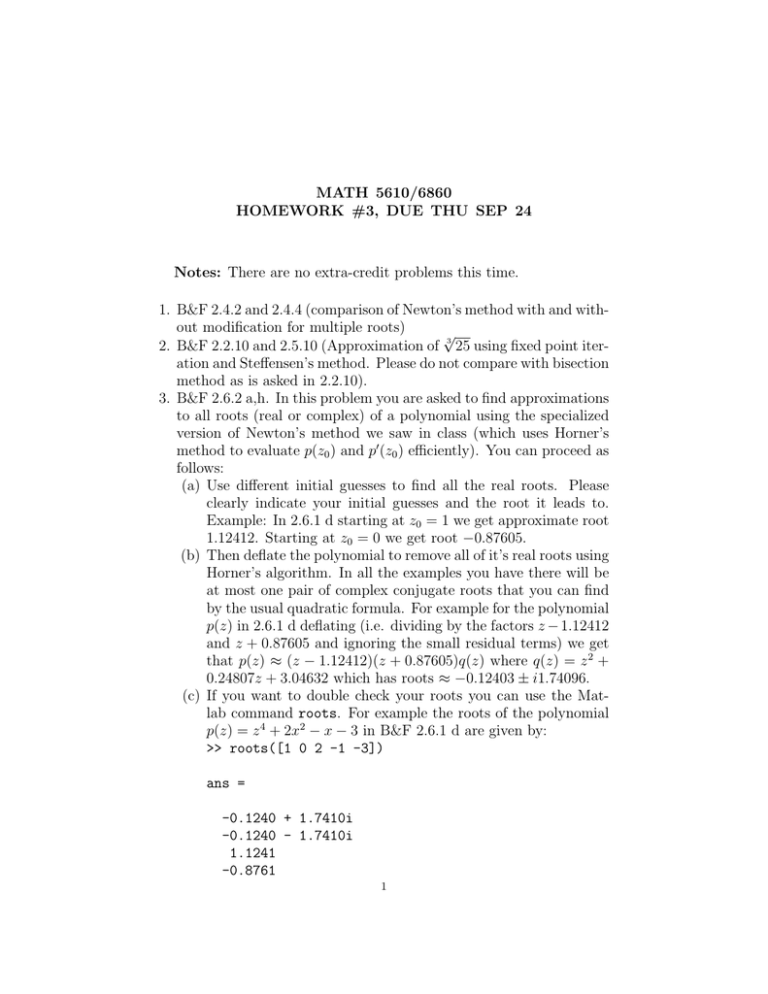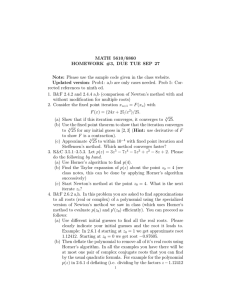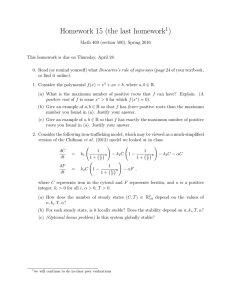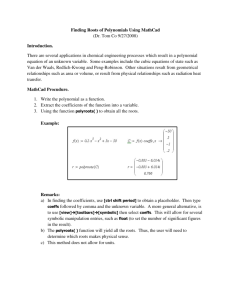MATH 5610/6860 HOMEWORK #3, DUE THU SEP 24
advertisement

MATH 5610/6860 HOMEWORK #3, DUE THU SEP 24 Notes: There are no extra-credit problems this time. 1. B&F 2.4.2 and 2.4.4 (comparison of Newton’s method with and without modification for multiple roots) √ 2. B&F 2.2.10 and 2.5.10 (Approximation of 3 25 using fixed point iteration and Steffensen’s method. Please do not compare with bisection method as is asked in 2.2.10). 3. B&F 2.6.2 a,h. In this problem you are asked to find approximations to all roots (real or complex) of a polynomial using the specialized version of Newton’s method we saw in class (which uses Horner’s method to evaluate p(z0 ) and p0 (z0 ) efficiently). You can proceed as follows: (a) Use different initial guesses to find all the real roots. Please clearly indicate your initial guesses and the root it leads to. Example: In 2.6.1 d starting at z0 = 1 we get approximate root 1.12412. Starting at z0 = 0 we get root −0.87605. (b) Then deflate the polynomial to remove all of it’s real roots using Horner’s algorithm. In all the examples you have there will be at most one pair of complex conjugate roots that you can find by the usual quadratic formula. For example for the polynomial p(z) in 2.6.1 d deflating (i.e. dividing by the factors z − 1.12412 and z + 0.87605 and ignoring the small residual terms) we get that p(z) ≈ (z − 1.12412)(z + 0.87605)q(z) where q(z) = z 2 + 0.24807z + 3.04632 which has roots ≈ −0.12403 ± i1.74096. (c) If you want to double check your roots you can use the Matlab command roots. For example the roots of the polynomial p(z) = z 4 + 2x2 − x − 3 in B&F 2.6.1 d are given by: >> roots([1 0 2 -1 -3]) ans = -0.1240 + 1.7410i -0.1240 - 1.7410i 1.1241 -0.8761 1 2 MATH 5610/6860 HOMEWORK #3, DUE THU SEP 24 4. K&C 3.5.1–3.5.3. Let p(z) = 3z 5 − 7z 4 − 5z 3 + z 2 − 8z + 2. Please do the following by hand. (a) Use Horner’s algorithm to find p(4). (b) Find the Taylor expansion of p(z) about the point z0 = 4 (see class notes, this can be done by applying Horner’s algorithm successively) (c) Start Newton’s method at the point z0 = 4. What is the next iterate z1 ? 5. K&C 3.5.11, 3.5.12 Recall that any polynomial of degree n can be written as p(z) = c(z − z1 )(z − z2 ) . . . (z − zn ) and that the multiplicity of a root is the number of times it is repeated in the factored form of p(z). Please show the following statements without using Thm 2.10 or Thm 2.11 in the textbook. (a) If z∗ is a root of multiplicity m of p(z) then p(z∗ ) = p0 (z∗ ) = . . . = p(m−1) (z∗ ) = 0 but p(m) (z∗ ) 6= 0. Hint: You may use Leibniz’s generalized product rule: n X n! (n) (f g) (z) = f (k) (z)g (n−k) (z). k!(n − k)! k=0 (b) The converse of previous statement. Hint: Use Taylor expansion of p(z)about z∗ .







